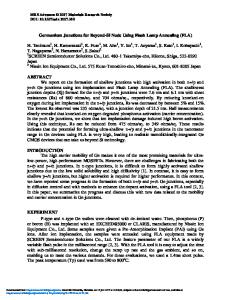Advanced Thermal Processing of Semiconductor Materials by Flash Lamp Annealing
- PDF / 166,932 Bytes
- 6 Pages / 612 x 792 pts (letter) Page_size
- 12 Downloads / 312 Views
C4.16.1
Advanced Thermal Processing of Semiconductor Materials by Flash Lamp Annealing W. Skorupa 1,2, D. Panknin 1, M. Voelskow 1, W. Anwand 1, and The European FLASiC Consortium*, T. Gebel 2, R. A. Yankov 2, Silke Paul 3, Wilfried Lerch 3 1
Forschungszentrum Rossendorf e.V., Institute of Ion Beam Physics and Materials Research, Dresden, Germany 2 nanoparc GmbH, Dresden - Rossendorf, Germany 3 Mattson Thermal Products GmbH, Dornstadt, Germany ABSTRACT The use of flash lamp annealing for processing semiconductor materials is outlined. Specific applications include ultra-shallow junction formation and heteroepitaxial growth of improved quality thin films of cubic silicon carbide. It is demonstrated that flash lamp annealing holds great promise as a technique for fabricating novel devices. INTRODUCTION Rapid thermal processing (RTP) methods are increasingly needed in the manufacture of semiconductor devices. To meet this demand, considerable research is underway, including efforts to gain a deeper insight into the underlying physics as well as to enhance the performance of the RTP systems through the use of a variety of energy sources and heating configurations. An important RTP application is in the formation of ultra-shallow junctions (USJs). Presently, the fabrication method of choice involves low energy dopant implantation followed by short time annealing [1,2]. Of the USJ anneal approaches, tungsten-halogen spike RTP is the current industry state-of-the-art. This technique has proven adequate to control the mainstream device processing, but will soon become unsuitable for the USJs required for the integrated circuits (ICs) of the future. The reason is that even effective anneal times in the range of 0.1 to 1 s, typical of advanced spike RTP, appear to be too long in order to limit diffusion and maintain good control over ultra-shallow implant profiles. Therefore, in the past several years, research has turned to the development of novel ultra-fast heat treatment methods, of which flash lamp based RTP is presently among the most promising ones. This is highlighted by the fact that flash lamp assisted process technologies are being actively pursued by major commercial companies such as Toshiba[3] and Vortek [4]. We have developed and tested successfully a version of ultra-rapid thermal processing based on the use of a xenon flash lamp system, referred to as the flash lamp annealing (FLA) technique. FLA is a “one-flash-one-wafer” method whose main attributes are the ease andcontrol of processing over large wafer batches. A similar technique, namely Flash Assist (fRTP), has been developed by Vortek making use of an arc lamp [4]. This paper provides an overview of our recent progress in the use of FLA for the thermal processing of semiconductor materials. Specifically, our research effort has been directed along ______________________________________________________________________________ * FZR group and G. Ferro,Y. Monteil,Univ. Claude Bernard Lyon 1, France, A.Leycuras, CNRS-CRHEA, Valbonne, France, J. Pezoldt TU
Data Loading...








